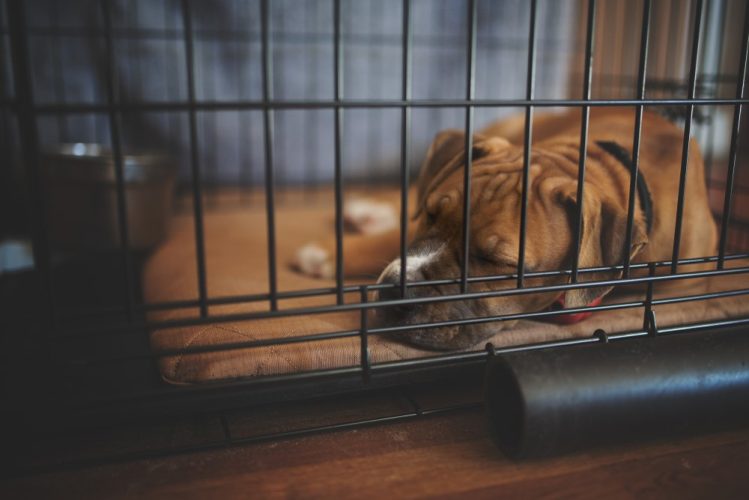Dog Whining in a Crate All of the Sudden – The Six Common Reasons
If you’re a new dog owner or have years of experience with dogs, you’ll quickly become familiar with your dog crate and crate training, which keep your pet safe and secure when you’re out. While crates are spacious, clean, and comfortable for your pet, it’s not uncommon when a dog whining in a crate happens, which may be due to several reasons.
Dogs are social animals, and they enjoy companionship, though they will adapt to a bit of solitude when you go to work or leave for a few hours during the day. If you encounter your dog whining in the crate, there are a few common reasons to get acquainted with, so you can help comfort your pet and help them adjust to the crate.
1. Your Puppy is Hungry or Thirsty
One of the most common reasons your puppy cries in its crate is due to hunger or thirst. This situation is especially likely if your dog is a puppy; they grow quickly and actively train or play frequently. It’s essential to keep a fresh bowl of water in the crate, and a bit of food, such as nutritious treats or light meals. giriş hiltonbet
If your dog has specific meal times, this can be factored into when and how long they remain in their crate. A short time frame may only need some fresh water and a snack, while a few hours may require a full meal to accommodate your dog’s daily routine. Once they realize their meals will remain uninterrupted, this can ease their worries of staying in the crate.
2. Previous Memories of Crates
While you may provide the most nurturing and supportive environment for your dog when crate training, they may have negative experiences from a previous home or kennel while they were kept in their crate. If they spend a lot of time in a crate, around strangers and other dogs with loud noises, strong smells, and disturbances, they may become scared of returning to that situation and associate this with the crate.
This is especially true if you have a rescue dog that was adopted from a kennel environment. They may become frightened of crates if they worry you might leave them behind if they have severe separation anxiety. For this reason, they may associate crates with being abandoned or with visiting a veterinarian where they had a medical procedure that caused discomfort or pain. It’s essential to remain patient with dogs who may associate crates with a scary situation or experience by creating a comfortable space for them.
3. Sensing Change
If you’re moving, making renovations, or other changes that the dog senses, this can be a source of stress and concern for them and may result in a crying puppy. Buying a new crate and changing the layout of your home, for example, can cause your dog to feel insecure and frightened about these changes because they don’t recognize this behavior. Their whining is to let you know they are unsure about what’s happening, even if it’s a slight change, such as an outdoor event or a local construction outside your home.
Recreating the same environment using familiar blankets, toys, and items in the crate can help ease a dog’s worries and give them a sense of stability. When you speak in quiet, soothing tones and give them positive attention, you’ll reassure your dog that everything will be okay, which can help them adapt to a significant change in their home.
4. Change in Sleeping Habits
If a dog isn’t accustomed to staying in a crate, it may get bored quickly and sleep more than usual. This Change in sleeping habits may cause dogs to become restless, especially if they nap less over time and want to explore their surroundings outside the crate. The amount of rest your dog needs also changes as they age, which usually leads to less sleep in the long term.
Once you get acquainted with your pet’s new sleeping schedule, you can accommodate their time in the crate as best as possible. The need for extra rest is also common in a rescue dog, but it decreases over time and can cause them to whine in their crate for an extended period.
5. The Crate is Isolated
If the crate is far from you or familiar surroundings, this can cause anxiousness, separation anxiety, and stress in your dog. They may whine because they don’t know where you are or recognize their surroundings. Moving the crate closer to you, or making the area more comfortable, with your dog’s favorite toy and blankets can ease their worries and help them relax.

When you notice your dog becomes upset at the sight of the crate or just after they enter, it’s best to remove them immediately. Use calm words and familiar phrases to comfort them before re-introducing the crate, or move it to an area that’s more comfortable or familiar. It’s essential to prepare your dog for when you leave for an hour or so by practicing for shorter periods until they become confident in your return to them.
6. They Need More Physical Activity
Some dogs crave more physical activity than others, and regular exercise is a great way to keep them healthy, physically, mentally, and emotionally. If they don’t receive enough outdoor exposure or stimulation, they may become upset and restless in the crate. The best way to avoid this situation is to take your dog outside or take it for a walk with your dog before placing them in the crate. This habit will ensure they are relaxed and may enjoy a rest shortly after.
Summary
There are many reasons why your dog may not quickly adapt to staying in a crate due to changing scenery, new items in the home, and changes to their schedule. It’s best to accommodate your pet’s schedule as closely as possible while helping them adapt to staying in the crate for short time frames until they can remain for several hours. Your dog will learn to trust you as you calm them during the first stages of getting used to the crate, and eventually, they will have no difficulty settling in.
It’s crucial to ensure the crate is large enough for the size of your dog, so they can comfortably move around and sleep when they need to rest. While rescue dogs may take longer to adjust to crates, most dogs are easy to work with, even if it takes a bit longer than expected. Provide as much comfort as possible so that your dog will associate the crate with a positive experience.

